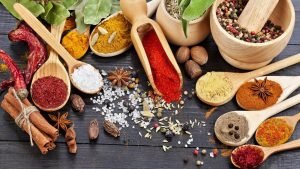 I love my job. I get to see so many interesting people and learn so much from my clients that it’s amazing and fun. I have one woman who I would rank right up there when it comes to eating healthy. She grows much of her own food and raises herbs, too. She’s a wealth of knowledge when it comes to adding herbs to meals. She even gave me several ideas on how I can create healthier meals with herbs and spices. Her approach was simple. She cut herbs every morning, put them in a glass and when she made supper, just threw in a few with each dish. I took it a step further, since I don’t grow my own, but should. Here are some ways to use herbs and their health benefits.
I love my job. I get to see so many interesting people and learn so much from my clients that it’s amazing and fun. I have one woman who I would rank right up there when it comes to eating healthy. She grows much of her own food and raises herbs, too. She’s a wealth of knowledge when it comes to adding herbs to meals. She even gave me several ideas on how I can create healthier meals with herbs and spices. Her approach was simple. She cut herbs every morning, put them in a glass and when she made supper, just threw in a few with each dish. I took it a step further, since I don’t grow my own, but should. Here are some ways to use herbs and their health benefits.
Basil comes in a lot of different varieties.
There are an endless amount of varieties of basil. Sweet basil is the most common variety and is often used in pesto. Genovese basil is also used in popular Italian dishes. Thai basil with its licorice flavor graces Asian dishes. Lemon and lime basil are great for desserts and fish. I also use lemon basil with pork. I love smelling cinnamon basil, but also adding it to my favorite healthy chili dish. Each one has a different taste and slightly different nutritional and health benefits. On the whole, basil is an anti-inflammatory and antioxidant. It contains cinnamanic acid, which studies show helps to enhance circulation, improve breathing if you have a respiratory disorder and stabilize blood sugar. If you have an abundance of basil, throw a few extra leaves in your salad for more flavor and nutrition. It contains vitamin A, K, C, Magnesium, iron, potassium and calcium with almost no calories.
Chives are so rewarding and you can eat the flowers.
A number of studies have been done with chives on its effects as a cancer fighter. It’s shown to reduce the risk of several types of caner when consumed regularly. It also contains choline that helps with brain functions, muscle movements and sleep and can help build bones with the vitamin K, while also reducing inflammation. Add them to almost any main dish for additional oniony flavor. Use both the stems and flowers in salads. Chives contain folate, calcium, magnesium, vitamin K, phosphorus, choline and potassium, but hardly any calories. One tablespoon is about one calorie.
With Coriander, you get a two-fer.
If you grow coriander and cut the stems early, you’ll have cilantro. Let them go to seed and you have coriander seed. It’s amazing, but cilantro, the leaves, have higher vitamin content and corriander has a higher mineral content. Cilantro contains higher amounts of vitamins A, K and E and the seeds, coriander, had more copper, phosphorous, selenium, potassium, zinc, manganese, iron, magnesium and calcium. Pair coriander with fruit and cruciferous vegetables. Use cilantro in stir fry and of course, salsa and guacamole.
- You don’t have to follow a recipe to get the benefits of herbs. Try throwing them in a salad or add to stir fry at the last minute before serving.
- Lemon balm is from the mint family, so if you grow it, it will spread, but mostly by seeding. It’s a great addition to dishes with fish, sea food and even with asparagus. Anywhere you’d use lemon, lemon balm can boost the flavor. It has a number health benefits. Use it for a refreshing summer tea.
- Fennel is a favorite of mine. It’s beautiful soft ferny fronds create a great display. It smells like licorice and I’ve eaten both the leaves and seeds to settle my stomach. You can also eat the bulb. It contains sodium, potassium, Vitamin A, C, B6, E, K, calcium, iron, magnesium, zinc, copper, manganese, niacin, folate, choline, lutein and pantothenic acid.
- Lemon grass, rosemary, thyme, sage and many other herbs add extra nutrition to every dish. The curcumin in turmeric has also been studied for its anti-inflammatory and antioxidant benefits. It’s even been researched as a possible cure for Alzheimer’s.
